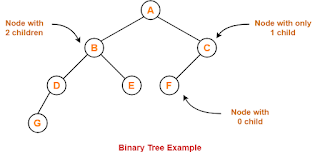Binary
Tree:
Binary tree is a special tree data structure
in which each node can have at most 2 children.
Thus, in a binary tree, each node has either 0 child or 1
child or 2 children.
Binary Tree is a special type of generic tree in which, each
node can have at most two children. Binary tree is generally partitioned into
three disjoint subsets.
- Root of the node
- Left sub-tree which is also a binary tree.
- Right binary sub-tree
A binary Tree is shown in the following image.
Unlabeled Binary Tree:
A binary tree is unlabeled if
its nodes are not assigned any label.
Example:
Consider we want to draw all the binary trees possible with
3 unlabeled nodes.
Using the above formula, we have-
Number of binary trees possible with 3 unlabeled nodes
= 2 x 3C3 / (3 + 1)
= 6C3 / 4
= 5
Thus,
- With 3 unlabeled nodes, 5 unlabeled binary trees are possible.
- These unlabeled binary trees are as follows-
Labeled Binary Tree:
A binary tree is labeled if all
its nodes are assigned a label.
Example:
Consider we want to draw all the binary trees possible with
3 labeled nodes.
Using the above formula, we have
Number of binary trees possible with 3 labeled nodes
= { 2 x 3C3 / (3 + 1) } x 3!
= { 6C3 / 4 } x 6
= 5 x 6
= 30
Thus,
- With 3 labeled nodes, 30 labeled binary trees are possible.
- Each unlabeled structure gives rise to 3! = 6 different labeled structures.
Similarly,
- Every other unlabeled structure gives rise to 6 different labeled structures.
- Thus, in total 30 different labeled binary trees are possible.















No comments:
Post a Comment